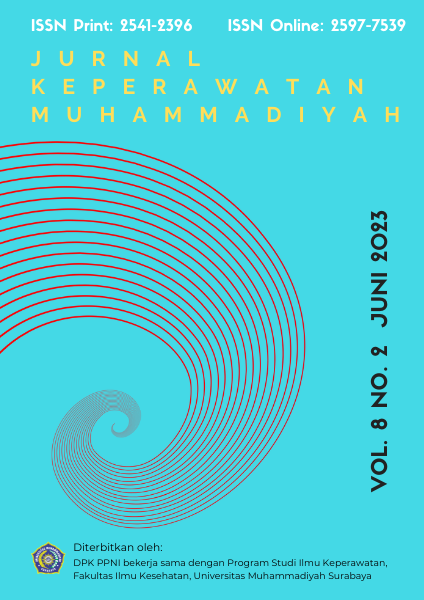Intensifikasi Ibu Hamil Dalam Mengikuti Kelas Ibu Di Wilayah Kerja Puskesmas Karangayu Kota Semarang Tahun 2022
DOI:
https://doi.org/10.30651/jkm.v8i2.16932Keywords:
Intensification of Pregnant Women, Mother Class, Pregnant MotherAbstract
Background: The class for pregnant women is an opportunity for pregnant women and their families to learn together about the health of pregnant women, which is carried out in groups. The holding of the Pregnant Women's Class (KIH) is implemented by providing facilities for pregnant women to study groups in the form of face-to-face meetings, and the implementation is carried out by midwives and involving all pregnant women, spouses, and/or spouses, providing increased utilization of health in maternal services in Indonesia.
Objective: The purpose of this study was to describe the intensification of pregnant women participating in maternal classes in the working area of the Karangayu Health Center.
Methods: The type of research used is quantitative research with descriptive methods. The population of this study was pregnant women in the working area of the Karangayu Health Center, Semarang City, in September - November 2022 and the sample used was 35 respondents who were taken using a total sampling technique.
Results: The results showed that of the 35 respondents there were working mothers as many as 19 respondents (54.3%) had never participated in maternal classes, mothers who were in the second trimester of pregnancy as many as 20 respondents (57.1%) who had never participated in maternal classes and mothers who parity of more than one as many as 23 respondents (65.7%) who never participated in mother class.
Conclusion: Most f the respondents never participated in classes for pregnant women due to working mothers when working with the implementation of mothers' classes colliding with each other, second-trimester mothers who lack family support, especially husbands and mothers with more than one parity due to having experience in previous pregnancies.
References
Astuti, S., & Susanti, A. (2016). Asuhan ibu dalam masa kehamilan : buku ajar kebidanan- antenatal care ( anc ) Ed. 1, Cet. 1. Jakarta: Erlangga.
Badan Pusat Statistik. (2016). Potret Awal Tujuan Pembangunan Berkelanjutan (Sustainable Development Goals) di Indonesia. Jakarta: Badan Pusat Statistik Indonesia.
Desmariyenti, D., & Hartati, S. (2019). Faktor Yang Berhubungan Dengan Keikutsertaan Ibu Hamil Dalam Kelas Ibu Hamil. JURNAL PHOTON , 9(2), 114-122. doi:https://doi.org/10.37859/jp.v9i2.1126
Devi, T. E. (2019). Asuhan Kebidanan Kehamilan : Dilengkapi Soal Uji Kompetensi Bidan, Jobsheet, Daftar Tilik, dan Dokumentasi Berbasis Bukti. Jakarta: Salemba Medika.
Dinas Kesehatan Kota Semarang. (2021). Profil Kesehatan. Kota Semarang: Dinkes Kota Semarang.
Hariyani , F., Murti, N., & Wijayanti, E. (2019). HUBUNGAN USIA, PARITAS, DAN KELAS IBU HAMIL DENGAN KOMPLIKASI PERSALINAN DI RSKB SAYANG IBU BALIKPAPAN. Mahakam Midwifery Journal, 2(5), 361 - 374. doi: http://dx.doi.org/10.35963/midwifery.v4i1.11
Hidayah, N., & et all. (2018). FAKTOR YANG MEMPENGARUHI PEMANFAATAN KELAS IBU HAMIL TAHUN 2018. JURNAL PHOTON, 9(1), 76-88. doi:https://doi.org/10.37859/jp.v9i1.1060
Kemenkes . (2019). Pedoman Pelaksanaan Kelas Ibu Hamil. Jakarta: Kemenkes RI.
Kemenkes RI. (2018). Pedoman Pelaksanaan Kelas Ibu Hamil. Jakarta: Kementerian Kesehatan Republik Indonesia.
Kemenkes RI. (2019). Profil Kesehatan Indonesia . Jakarta: Kementerian Kesehatan Indonesia.
Kementerian Kesehatan RI. (2014). Pedoman Pelaksanaan Kelas Ibu Hamil. Jakarta: Kemenkes RI.
Maharani, C. T., Sriatmi, A., & Suryoputro, A. (2018). Analisis Faktor Persepsi Ketentanan Ibu Terhadap Pemanfaatan Kelas Ibu Hamil di Puskesmas Gayamsari Kota Semarang. Jurnal Kesehatan Masyarakat (JKM) e-journal, 6(5), 33-38.
Mariam, Pratiwi, B. R., & Natalia, O. (2018). Hubungan Status Pekerjaan Ibu Hamil Dengan Partisipasi Mengikuti Kelas Ibu DI Puskesmas Mangkung Kecamatan Praya Barat Kabupaten Lombok Tengah Tahun 2018. Jurnal Kesehatan Qamarul Huda, 6(1), 31-35. doi:https://doi.org/10.37824/jkqh.v6i1.2018.12
Muhith, A., Fardiansyah, A., & et all. (2019). Pelaksanaan Kelas Ibu Hamil Sebagai Upaya Peningkatan Pengetahuan Ibu, Keluarga Dan Kader Dalam Deteksi Dini Resiko Tinggi Ibu Hamil Di Wilayah Kerja Puskesmas Sambeng Kabupaten Lamongan. Care : Jurnal Ilmiah Ilmu Kesehatan, 7(1), 37-44. doi:DOI: https://doi.org/10.33366/jc.v7i1.1084
Notoatmodjo, S. (2018). Metodologi Penelitian Kesehatan. Jakarta: Rineka Cipta.
OKLAINI, S. T., NENI, R., & et all. (2022). HUBUNGAN PENGETAHUAN DAN PARITAS DENGAN KUNJUNGAN KELAS IBU HAMIL DI WILAYAH KERJA PUSKESMAS MUARA KELINGI KABUPATEN MUSI RAWAS. Journal Of Midwifery, 10(2), 65-73.
Sinurat, L. R., & et all. (2021). Hubungan Dukungan Keluarga dengan Keikutsertaan Kelas Ibu Hamil di Klinik Bidan Wanti. JINTAN (Jurnal Ilmu Keperawatan), 1(2), 141-150. doi:https://doi.org/10.51771/jintan.v1i2.121
Sutanto , A., & Fitriana , Y. (2019). Asuhan pada Kehamilan. Jogyakarta: Pustaka baru press.
Warlenda, S. V., & Sari, N. P. (2020). DETERMINAN RENDAHNYA PARTISIPASI IBU HAMIL DALAM MENGIKUTI KELAS IBU HAMIL DI WILAYAH KERJA PUSKESMAS SUNGAI SALAK. Jurnal Ilmiah AVICENNA, 61-73. doi:DOI:10.36085/avicenna.v15i1.749.
Downloads
Published
Issue
Section
License
- Penulis tetap memegang hak atas karyanya dan memberikan hak publikasi pertama kepada jurnal ini yang secara simultan karya tersebut dilisensikan di bawah:Â Creative Commons Attribution-ShareAlike 4.0 International (CC BY-SA 4.0)













